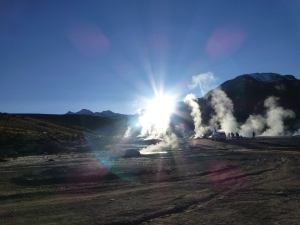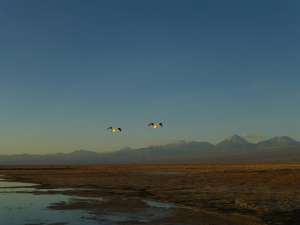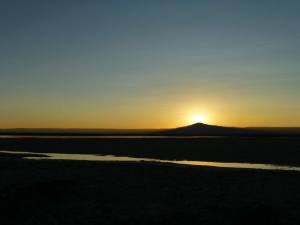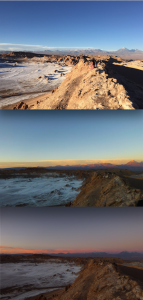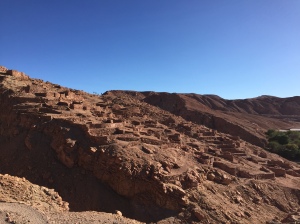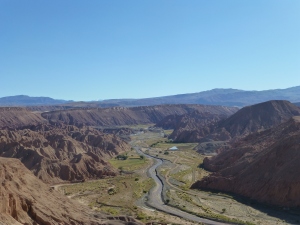But in the desert, in the pure clean atmosphere, in the silence – there you can find yourself.
― Father Dioscuros
I have had very limited experiences related to deserts. My grandparents lived in Phoenix when I was too young to realize the landscape I was walking through was different than lake-ridden Minnesota. 15 years later, I had to spend the night in Phoenix due to a delayed flight and a missed connection, and I though remember noticing a cactus next to the hotel the airline set me up in, that was my entire impression of the area. My first real desert experience was during my sophomore year of college, when I went on a two day trip to eastern Oregon. I remember hiking along a desert plateau alongside some shrubs by day and laying on the dirt to take in the stars by night. It was beautiful, peaceful, and a reminder that the earth is diverse and that beauty exists even in desolate places.
This past weekend I went to the driest and most desolate of deserts in the world with my program: the Atacama Desert, located in northern Chile. The desert is so dry that parts of it haven’t had any recorded rainfall since the Spanish conquered the area in the 16th century. Due to its combined dryness and lack of cities, it’s also known as one of the best places in the world to see stars, and houses some of the world’s most powerful telescopes and observatories.
The trip was magical. I was surrounded by beauty: beautiful landscapes, beautiful people, and a beautiful break from my routine. It was relaxing, enlightening, and left me awestruck. I think the common denominator of the highlights of the trip was the overbearing presence of the sky.
The desert, when the sun comes up…I couldn't tell where heaven stopped and the Earth began.
― Tom Hanks (Forrest Gump)
On Sunday morning we left our hostel at 5:30 AM to travel to El Tatio; which, at 15,000 feet, contains some of the highest altitude geysers in the world, and is the largest geyser field in the southern hemisphere. Our goal was to get there before sunrise, so that we could see the light hit the steam from the geysers as the sun rose.
It was beautiful. Cold (about 15 F), but beautiful. The sky slowly changed from dark grey to bright blue, and the steam suddenly appeared white in the sun. Almost as immediate as the changing color of the steam was the warming of the air, which started to heat up and we began stripping off the layers upon layers we had been wearing. We continued to warm up by eating hard boiled eggs cooked in the geysers themselves and drinking what may have been the best nescafé of my life (rivaling the nescafé I drank in somehow-warmer Patagonia).
Night poured over the desert. It came suddenly, in purple. In the clear air, the stars drilled down out of the sky, reminding any thoughtful watcher that it is in the deserts and high places that religions are generated. When men see nothing but bottomless infinity over their heads they have always had a driving and desperate urge to find someone to put in the way.
― Terry Pratchett, Jingo
We also managed to see two amazing sunsets. The first was on Saturday, after we had spent a couple of hours exploring the Salar de Atacama; the third largest salt flat in the world. The salt changed from white to grey as the sky darkened, and the mountains in the distance began to reflect the pink from the sky. The flamingos enjoying the briny waters of the lagoons in the salt flat continued to feed as the sun went down, and a single mountain was silhouetted as the sun disappeared directly behind it.
The second was on Sunday, seen from a vantage point hiked up to in the Valley of the Moon. The valley is named so for its resemblance to the terrain of the moon, which is so similar that NASA has used the valley to test rovers and practice projects in the past. We were told not to watch the sun itself, but instead look east and watch the changing colors of the mountains. It was incredible.
When you look at the stars and the galaxy, you feel that you are not just from any particular piece of land, but from the solar system.
Kalpana Chawla
Almost all of our group went out after dinner on Thursday to find a dark spot to lie back in and look at the stars. It didn’t take more than ten minutes of walking away from our hostel to find almost complete darkness, and as we spread out along a river bank it was hard to feel like it was all real. The milky way (la vía láctea, in Spanish) was bright and obvious, and as I laid back in the sand the same way I did in Oregon almost two years ago, and in South Dakota almost two years before that, and in all my trips to the Boundary Waters and in all of the moments I’ve been lucky enough to find such darkness, I was reminded again of how small I am.
On our last night, I went on a tour to a nearby observatory with a large chunk of my group. We were given access to one of the largest telescopes (open to the public) in the desert. The guide started us out by pointing it at Jupiter and showing us its rings and some of its moons. He continued, showing us another galaxy, a nebula, a black hole. It was difficult to wrap my mind around what all we were seeing. He finished by showing us Saturn, whose ring was clear and made the planet look just like the glow-in-the-dark Saturn that kids put on their ceilings alongside glow-in-the-dark stars. Once done with the telescope, we were given a presentation about the sheer vastness of the universe. He showed Earth next to Jupiter, Jupiter next to the Sun, the Sun next to a series of bigger stars next to our galaxy next to our cluster next to all of the observable universe. Then he started talking about he possibility of observable universes. To top it off, we went back outside and he showed us constellations and shapes and another galaxy visible to the naked eye. It was a humbling experience, and one that I’m obviously still thinking about three days later.
Once again there was the desert, and that only.
― Stephen King, The Gunslinger
The sky was not the only beautiful part of the experience. We went for a number of hikes, through a mountain range formed by the deposition of minerals due to evaporated rain, up a hill overlooking an ancient fortress with a 360 degree view of the area, to a viewpoint over Death Valley and up some lookouts in Moon Valley. The desert was vast, empty, with few plants and lots of dirt. Somehow there were colors everywhere: slight variations in the color of rock, bright colors in the sky, and the few plants not trying to hide themselves at all. It was beautiful, and unlike anything I’d ever seen before.
This trip gave me a lot of time to think, and a lot to think about. It’s one of my favorite things I’ve done here. I’m amazed that Chile can include so much diversity, from the Atacama desert in the north to Patagonia in the south. There’s still so much of it I want to see!
As always, email me with any questions about Lewis & Clark! My email is rekidder@lclark.edu
Rebecca
